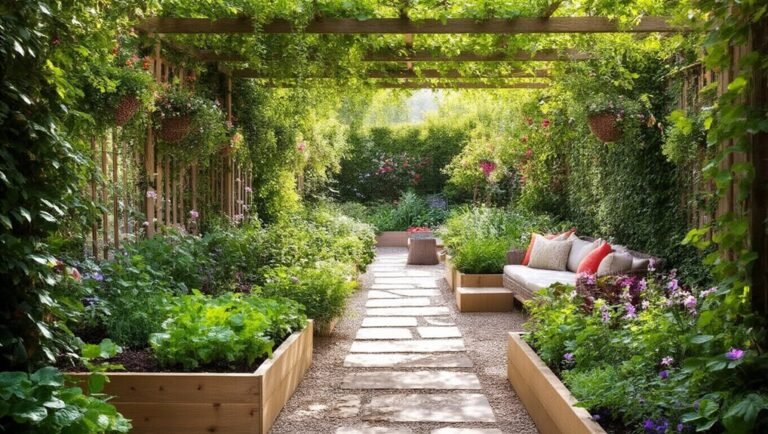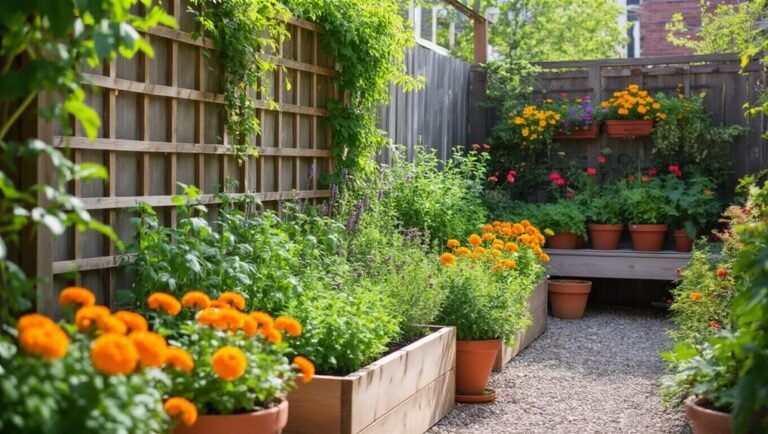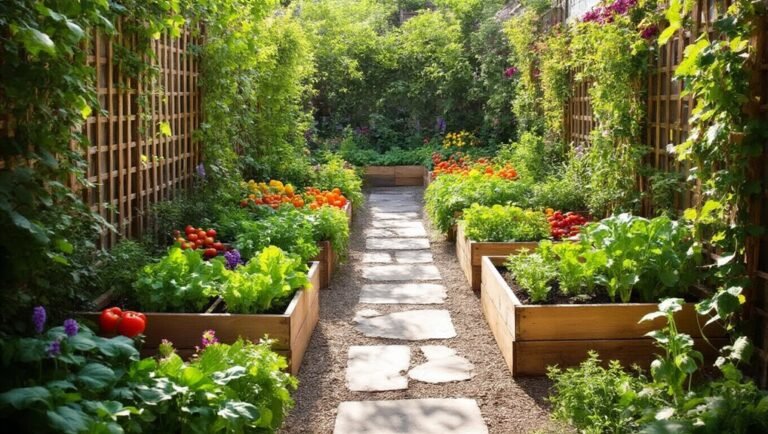To style indoor plants like a pro, start by assessing your space and light conditions. Choose plants that thrive in your environment and fit your maintenance routine. Select pots that complement your decor and allow for proper drainage. Arrange your plants to create impactful displays, using accessories for added flair. Don’t forget to consider seasonal styling and maintenance for vibrant growth. Discover techniques that can elevate your indoor plant game even further.
Key Takeaways
- Assess your space’s light conditions to select appropriate plants that thrive in bright or low-light environments.
- Choose pots and planters that match your decor while ensuring proper drainage and size for healthy root growth.
- Strategically place plants near windows and cluster different varieties for a vibrant, visually appealing display.
- Incorporate seasonal accessories and decorative elements to enhance aesthetics and reflect changing times of the year.
- Maintain plant health through regular watering, dusting leaves, and monitoring for pests to ensure thriving indoor greenery.
Understanding Your Space and Light Conditions
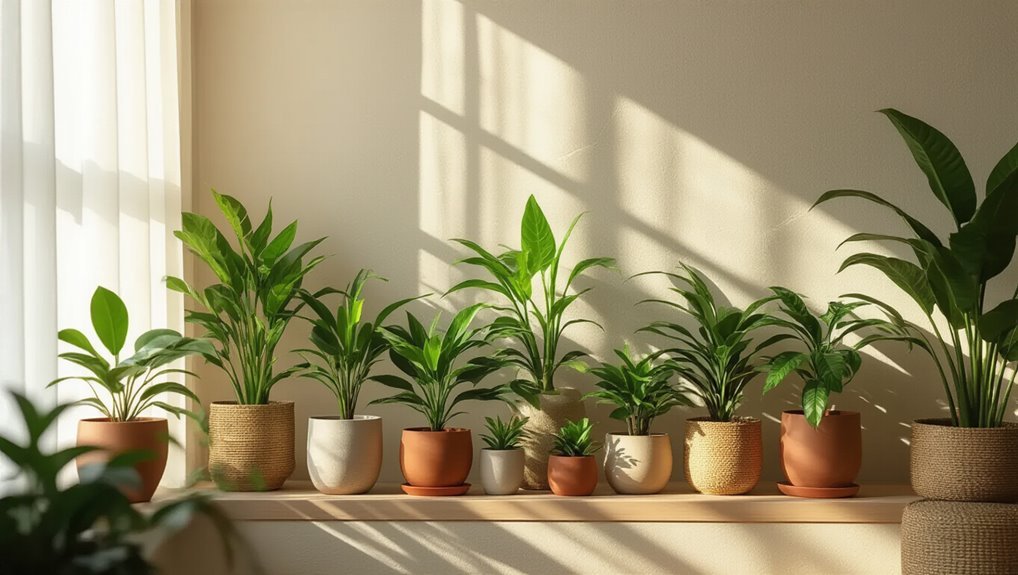
When you’re choosing indoor plants, understanding your space and light conditions is crucial for their health and vitality.
Start by assessing how much natural light your room receives throughout the day. South-facing windows provide bright light, while north-facing ones offer lower light levels. You’ll want to identify any areas that may be too dim for plants that thrive in bright conditions. If you want to help your climbing plants grow vertically and add structure, consider incorporating a beautiful trellis to guide their growth indoors.
Next, consider your available space. Ensure you have enough room for pots and any necessary plant stands.
Think about the height and width of your plants, as well as how they’ll interact with your furniture and decor. By evaluating these factors, you’ll create an environment where your indoor plants can flourish beautifully and enhance your living space.
To make the most of your display, consider using stylish plant stands to elevate your greenery and add visual interest to your home décor.
Selecting the Right Indoor Plants
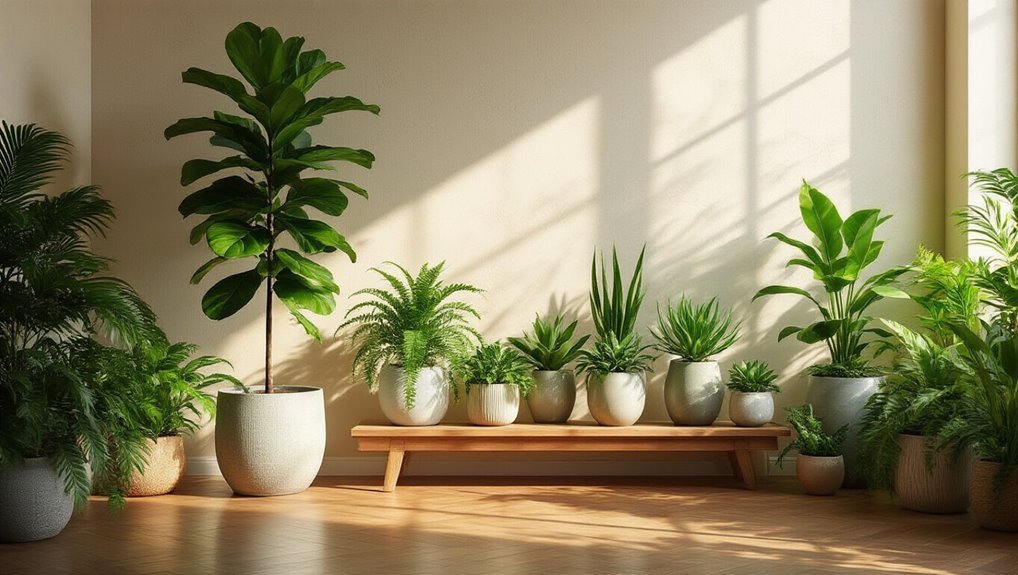
How do you choose the right indoor plants for your space? Start by considering your light conditions. If your room gets plenty of natural light, you can opt for sun-loving plants like succulents or fiddle leaf figs.
For low-light areas, choose resilient options like snake plants or pothos. Next, think about your lifestyle. If you travel often or forget to water, go for low-maintenance plants such as ZZ plants or peace lilies.
Also, consider the size of your space; larger plants can make a bold statement, while smaller ones can fit snugly on shelves or desks. If you want to grow plants and enjoy fresh herbs at home, you might try using herb garden kits with seeds and pots for a convenient and easy start.
Lastly, reflect on your personal style—choose plants that resonate with you, whether that’s lush greenery or structured, architectural shapes.
If you’re interested in adding both beauty and utility to your home, consider starting with an indoor herb garden to enjoy fresh flavors year-round.
Choosing the Perfect Pots and Planters
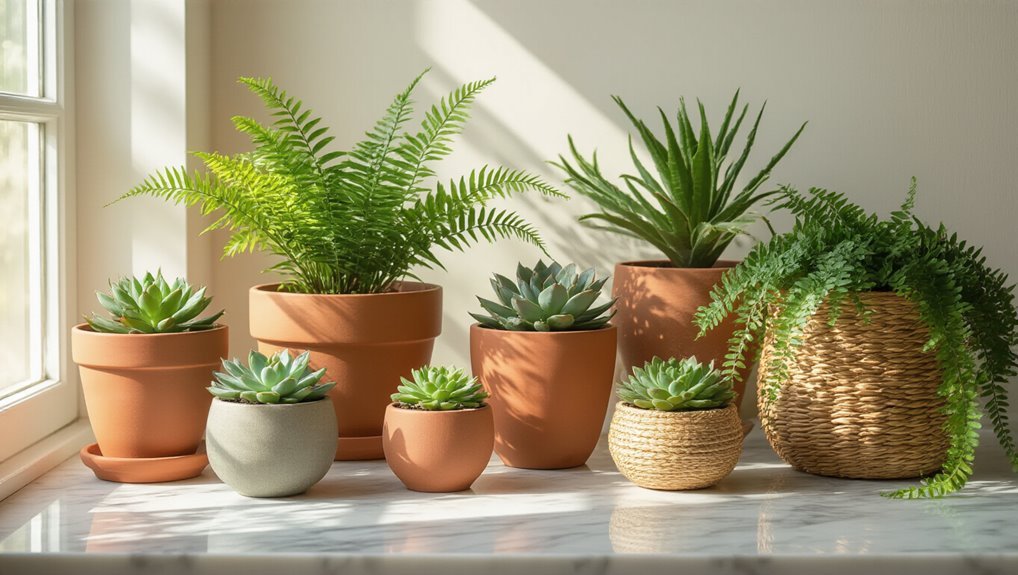
Choosing the perfect pots and planters can elevate your indoor plants’ aesthetic while ensuring they thrive.
When picking the right container, consider these key aspects:
- Material: Opt for ceramic, terracotta, or recycled materials that resonate with your style.
- Size: Ensure the pot has enough space for your plant’s root system to grow.
- Drainage: Look for pots with drainage holes to prevent root rot and promote health. Just as you prioritize proper footwear for gardening to support comfort and mobility, selecting planters with good drainage is essential for your plants’ well-being.
- Color and Texture: Choose finishes that complement your decor and enhance your plants’ beauty.
- Weight: Consider the pot’s weight for easy mobility and stability in your space.
For a curated selection of unique and stylish plant pots, you can elevate your space and find the perfect match for any interior design.
Creating a Cohesive Color Palette
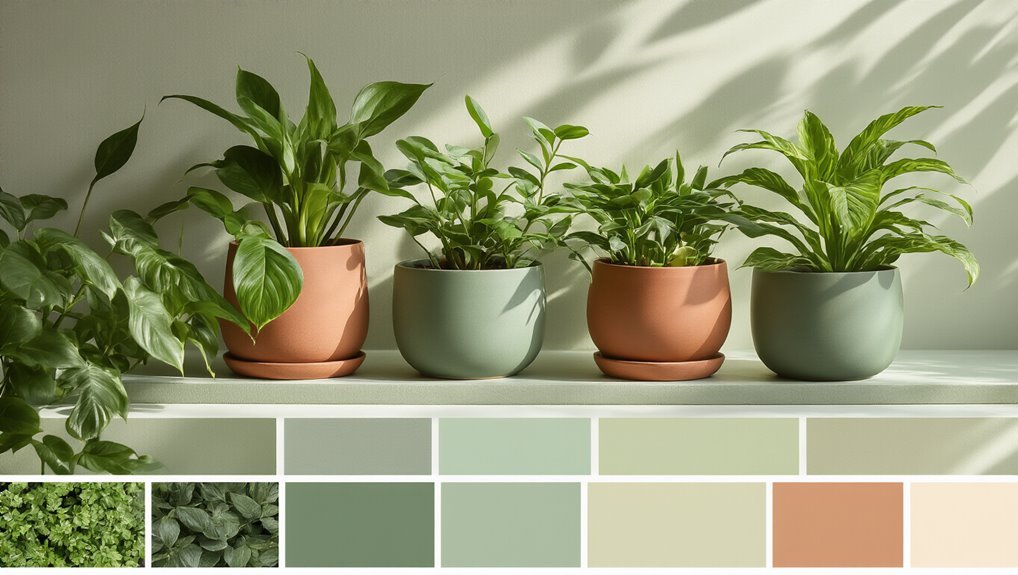
To create a cohesive color palette for your indoor plants, start by considering the hues that resonate with your overall decor and personal style.
Identify a color scheme that complements your space; think about warm tones, cool colors, or earthy shades. Choose planters that reflect this palette, whether through their materials, textures, or finishes. For hands-on work arranging your plants and pots, it’s helpful to use gardening gloves to protect your hands and keep your styling process comfortable.
Incorporating plants with leaves in various shades of green can add depth while maintaining unity. Don’t shy away from including colorful blooms, but make sure they harmonize with your chosen tones.
You can further enhance your space by selecting hanging planters that fit seamlessly within your chosen color scheme, adding both visual interest and vertical dimension to your indoor plant display.
Placement Strategies for Maximum Impact
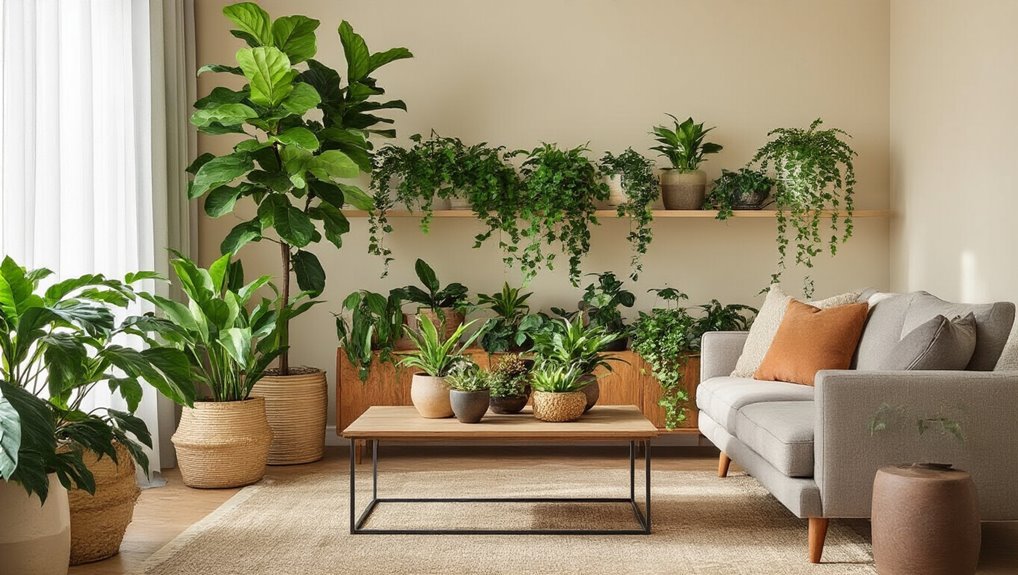
While you might think that any corner of your home can be a good spot for plants, strategic placement can truly elevate their impact.
Consider these tips to maximize your greenery’s presence:
- Highlight natural light: Place plants near windows for optimal growth and stunning visuals.
- Create focal points: Use larger plants as statement pieces in living areas or entryways.
- Group plants together: Cluster different varieties for a lush, vibrant display.
- Utilize vertical space: Hang plants or use shelves to draw the eye upward, adding dimension.
- Balance the room: Position plants across from furniture to create harmony and a sense of tranquility.
For an even more low-maintenance experience, try incorporating self-watering planters into your arrangements to keep your plants thriving with minimal effort.
To further enhance your display, consider incorporating Plant Propagation Stations to showcase new cuttings and add a unique decorative element to your indoor plant arrangements.
With these strategies, you’ll transform your space into a vibrant oasis!
Layering Heights and Textures
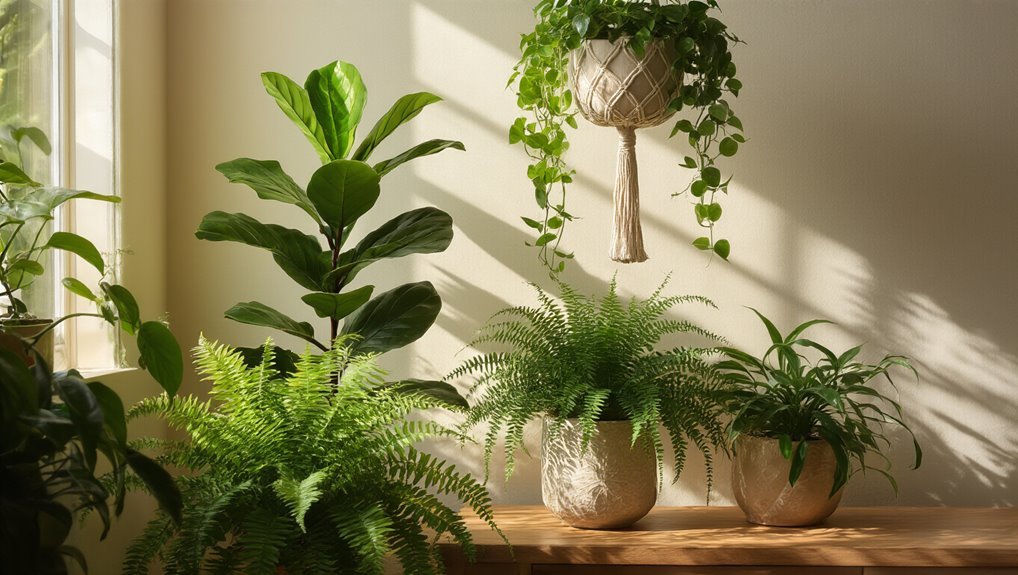
By incorporating a variety of heights and textures, you can create a dynamic and visually appealing indoor garden. Start by mixing tall plants, like fiddle leaf figs, with shorter varieties, such as succulents, to establish layers. Varying leaf shapes and sizes adds interest, too—think broad leaves paired with fine, delicate foliage. To ensure your succulents stay healthy and vibrant, consider using plant care kits designed specifically for their unique needs.
Here’s a quick guide to help you choose the right plants:
| Height | Plant Example |
|---|---|
| Tall | Fiddle Leaf Fig |
| Medium | Snake Plant |
| Short | Echeveria |
Experimenting with different textures, like glossy leaves next to matte ones, can further enhance your space. Keep your arrangement balanced and let each plant shine in its unique way! For those looking to expand their collection, starting with essential seed starting kits can make growing new varieties simple and successful.
Using Accessories to Enhance Your Plants
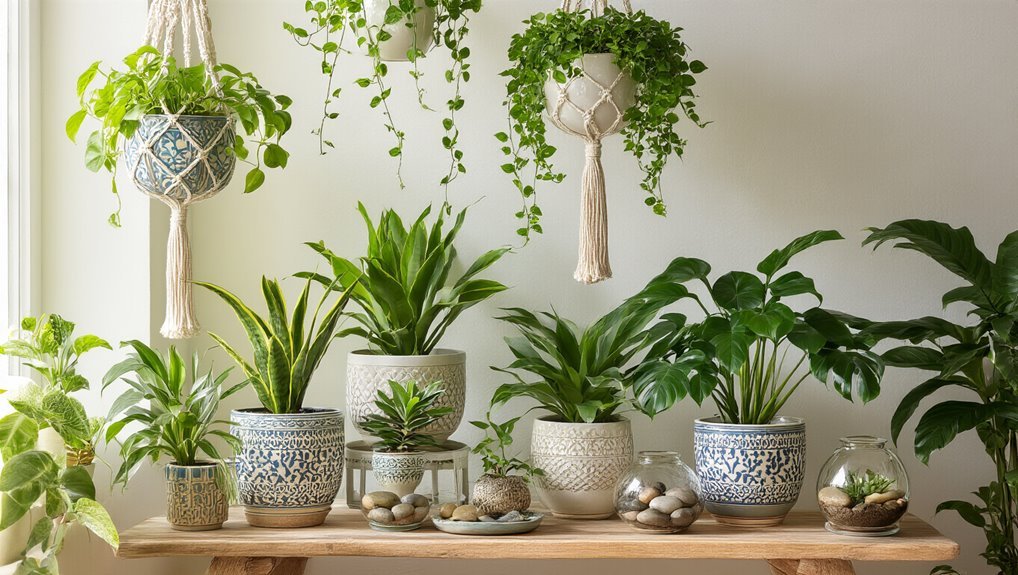
Enhancing your indoor plants with accessories can transform your space and highlight their beauty. Thoughtfully chosen items can create a stunning visual impact, making your plants the focal point of any room. To bring some of the charm of Decorative Birdhouses for Gardens into your home, consider selecting accessories that mimic outdoor garden accents.
Here are some accessories you might consider:
- Decorative pots: Choose colors and textures that complement your décor.
- Plant stands: Elevate plants to add dimension and interest.
- Hanging planters: Utilize vertical space and create a cascading effect.
- Moss or decorative stones: Use these as a top layer to enhance pot aesthetics.
- String lights: Add a whimsical touch while illuminating your plants.
For a touch of outdoor whimsy indoors, consider incorporating garden gnomes to bring character and charm to your plant displays.
Seasonal Styling Tips for Indoor Plants
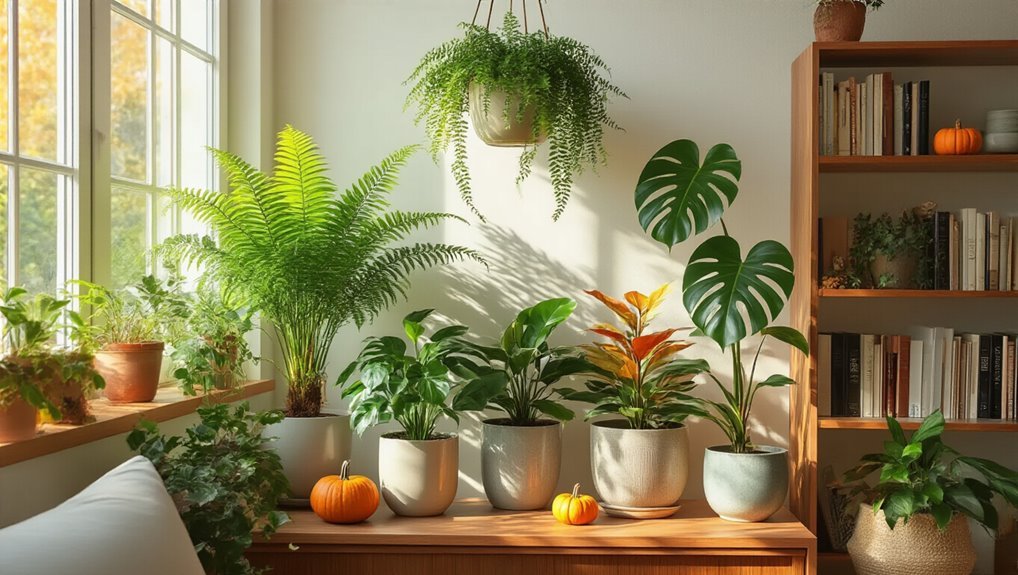
As the seasons change, your indoor plants can benefit from a little seasonal styling to reflect the mood and atmosphere of each time of year.
In spring, consider adding colorful pots or decorative trays to highlight new growth. You might also incorporate fresh flowers nearby for a vibrant touch. To ensure your plants thrive, use high-quality garden soil to provide essential nutrients during this period of active growth.
During summer, opt for lighter, airy displays that emphasize your plants’ lushness; think natural wood stands or woven baskets.
As autumn arrives, embrace warm tones with terracotta pots or golden-hued accessories, creating a cozy vibe.
In winter, bring in metallic accents or soft textiles to add warmth and cheer, making your indoor garden a comforting retreat.
Each season offers unique styling opportunities that enhance your plants’ beauty and energy.
For added versatility and improved plant health, consider using grow bags as they offer excellent drainage and aeration for your indoor garden throughout the year.
Maintenance and Care for Healthy Growth
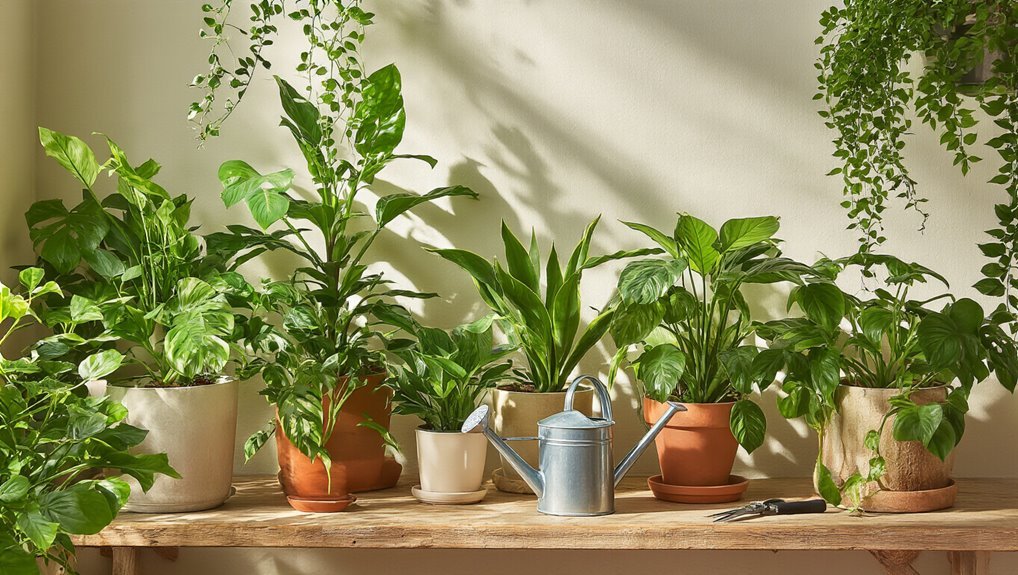
To keep your indoor plants thriving, consistent maintenance and care are key. Regular attention not only promotes healthy growth but also enhances the beauty of your space.
Here are some essential tips to ensure your plants flourish:
- Water wisely: Don’t overwater; let the soil dry out slightly between watering.
- Dust leaves: Clean leaves regularly to boost photosynthesis and keep your plants looking fresh.
- Fertilize: Use a balanced fertilizer during the growing season to provide nutrients.
- Monitor pests: Check for any signs of pests and address them promptly to prevent infestations.
- Adjust light: Rotate your plants to ensure even light exposure and avoid leggy growth.
With these simple steps, you can enjoy a vibrant indoor garden that brings joy to your home.
Inspiring Indoor Plant Arrangements to Try
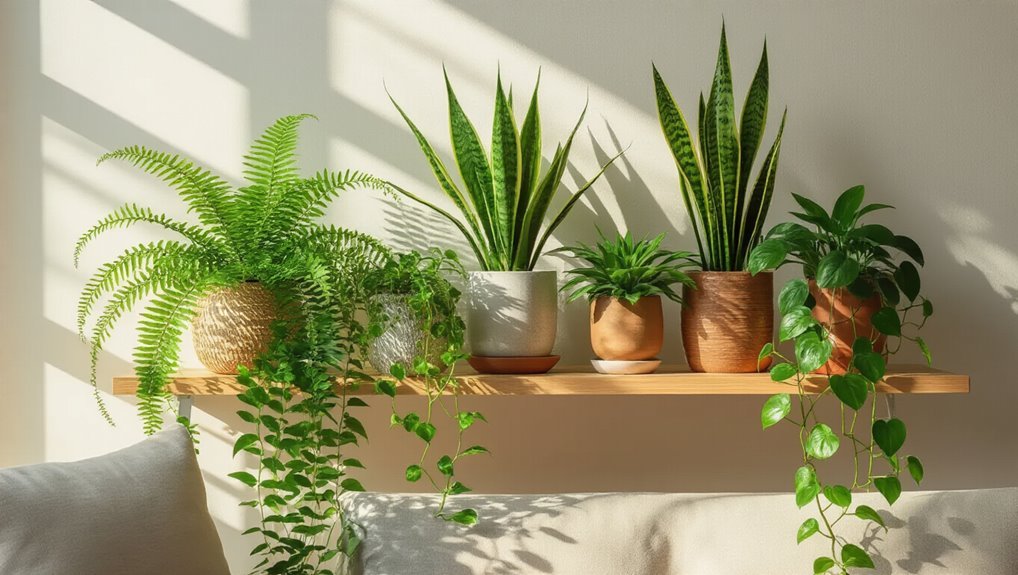
Creating inspiring indoor plant arrangements can transform your living space into a vibrant oasis.
Start by grouping plants of varying heights. Place taller plants like a fiddle leaf fig in the back, while shorter ones, such as succulents, can sit in front.
Mixing textures adds depth; combine leafy ferns with smooth succulents or spiky cacti. Use decorative pots or baskets to enhance visual interest, and consider a color palette that complements your decor.
Don’t forget to experiment with layering plants on shelves or hanging them from the ceiling.
Finally, create a focal point by showcasing a statement plant, like a monstera, in a prominent spot.
With these tips, you’ll cultivate arrangements that inspire and elevate your home’s atmosphere.
Frequently Asked Questions
How Do I Prevent Pests on My Indoor Plants?
Think of your indoor plants as thriving jungles, yet pests lurking like shadows. You can prevent them by regularly inspecting leaves, keeping humidity balanced, and using natural repellents—your plants will flourish, free from unwanted visitors.
Can Indoor Plants Improve Air Quality?
Yes, indoor plants can improve air quality. They absorb toxins and release oxygen, creating a healthier environment. By adding a few plants to your space, you’ll breathe cleaner air and enjoy a more vibrant atmosphere.
What Are the Best Indoor Plants for Beginners?
You might wonder which indoor plants are easiest for beginners. Consider starting with pothos, snake plants, and peace lilies. They’re low-maintenance, tolerant of various conditions, and will thrive even if you forget to water them occasionally.
How Often Should I Rotate My Plants?
You should rotate your plants every couple of weeks. This helps them receive even light exposure, promoting healthy growth. Just remember to gently turn them to avoid disturbing the roots or soil. Happy planting!
Can I Style Plants in a Bathroom?
Imagine your bathroom as a lush oasis. You can absolutely style plants there! Choose humidity-loving varieties like ferns or pothos, and watch them thrive in the steam while adding a touch of nature to your space.
Conclusion
By now, you’re equipped with the essential tips to style your indoor plants like a pro. Just as a painter blends colors to create a masterpiece, you can harmonize your greenery with your space. Remember to consider light, choose the right pots, and don’t shy away from accessories that enhance your plants’ beauty. With a little creativity and care, your indoor garden will flourish, bringing life and vibrancy to your home.
